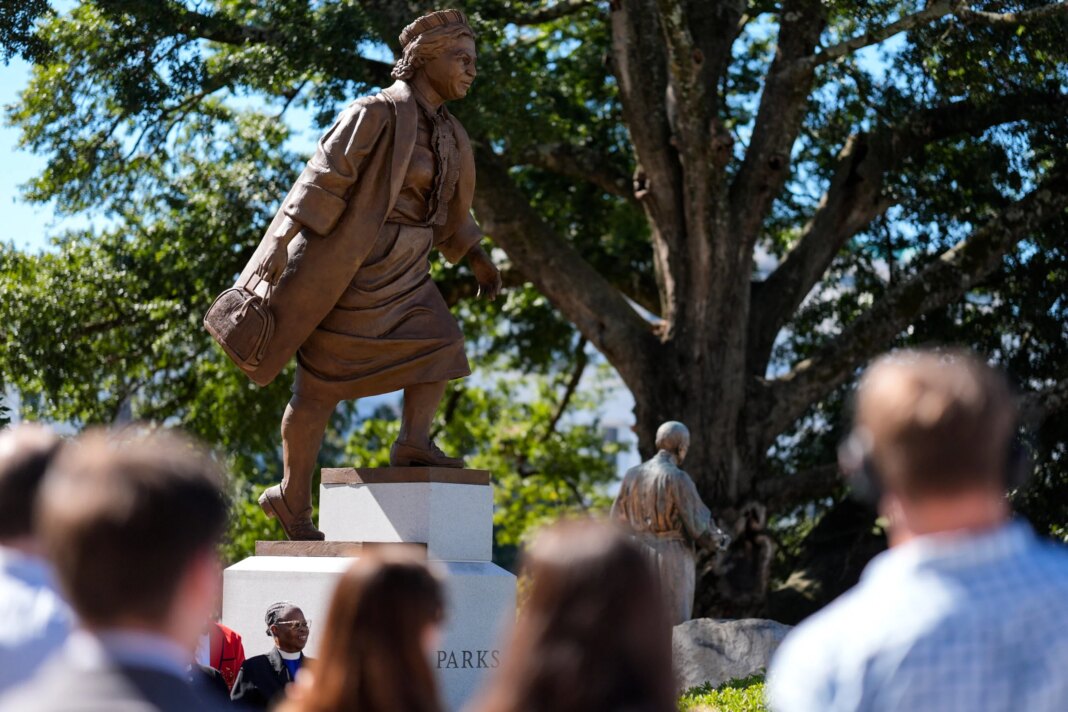Statues Unveiled to Honor Rosa Parks and Helen Keller at Alabama Capitol
On a momentous day in Montgomery, Alabama, the stories of two remarkable women—Rosa Parks and Helen Keller—were immortalized with the unveiling of their statues on the grounds of the Alabama Capitol. This historic occasion marked the first time that statues of women have been installed on the Capitol lawn, a significant step towards diversifying the narrative reflected in a location that has traditionally honored figures associated with the Confederacy.
The Impactful Lives of Parks and Keller
Rosa Parks, often revered as the “mother of the Civil Rights Movement,” made history on December 1, 1955, when she refused to give up her bus seat to a white passenger. While not the first to be arrested for resisting bus segregation, her courageous act sparked a yearlong boycott that became a pivotal moment in the struggle against racial injustice in the United States.
Helen Keller, born in 1880 in Tuscumbia, Alabama, faced immense challenges, becoming deaf and blind due to an illness before she turned two. With the guidance of her dedicated tutor, Anne Sullivan, Keller learned to communicate and went on to become a prolific writer and public speaker. Her advocacy encompassed not only the rights of individuals with disabilities but also workers’ rights and the plight of the underprivileged.
A Symbol of Courage
During the unveiling ceremony, Governor Kay Ivey highlighted the importance of these statues, describing Parks and Keller as having “shaped history through quiet strength and unwavering conviction.” She remarked, “Courage changes the course of history, and today, these statues stand as symbols of that courage.” This powerful message encapsulates the enduring impact both women had on the quest for justice and equality.
The statue of Rosa Parks, themed “a step into equality,” captures her poised before a bus, symbolic of her pivotal role in fighting against racial segregation. Positioning this statue near the statue of Confederate President Jefferson Davis adds a layered complexity to the narrative—one represents the struggle against the very injustices that Davis sought to uphold.
Historical Context and Controversy
The location of Parks’ statue is steeped in historical significance. Dexter Avenue, where the statue gazes down, is not only where Parks famously boarded the bus but is also intertwined with the legacy of slavery and civil rights. This juxtaposition between the statues serves as a visual representation of America’s ongoing struggle with its past and the fight for justice.
The unveiling took on special significance in the wake of heightened activism around the removal of Confederate monuments following the tragic events of 2015, when nine Black churchgoers were murdered by a white supremacist. The push for a more inclusive reflection of history has led to the removal of over 480 Confederate symbols across the country. However, Alabama laws make it challenging to remove longstanding monuments like that of Davis, underscoring the complexity of historical memory in the state.
Celebrating Keller’s Legacy
Helen Keller’s statue portrays her as a young woman sitting on a bench, a book resting in her lap that features instructions for tactile lipreading, inviting interaction from visitors. This approachable design reflects Keller’s philosophy that communication and connection can transcend barriers. Keller’s great-grandniece, Keller Johnson Thompson, expressed her pride in the honor, noting that both women’s stories exemplify the capacity to overcome obstacles and make a meaningful difference in the world.
Legislative Journey
The process of bringing these statues to life involved more than six years of advocacy. The Alabama legislature approved the project in 2019, with the Alabama Women’s Tribute Statue Commission overseeing its completion. Representative Laura Hall, who sponsored the legislation, emphasized the need for visitors to understand the full impact that women have had on history, irrespective of their race or political affiliation.
Hall stated, “Helen Keller and Rosa Parks just seemed to be the image that… you could identify with and realize the impact that they had on history.” This sentiment reflects the unifying power of Parks and Keller’s legacies as symbols of resilience and hope.
The unveiling of the statues not only honors the significant contributions of Parks and Keller but also serves as a reminder of the ongoing journey towards equality and justice in society. Their legacies continue to inspire future generations in the face of adversity, encouraging everyone to strive for a better world.



